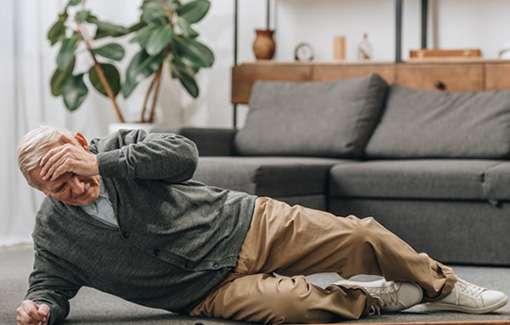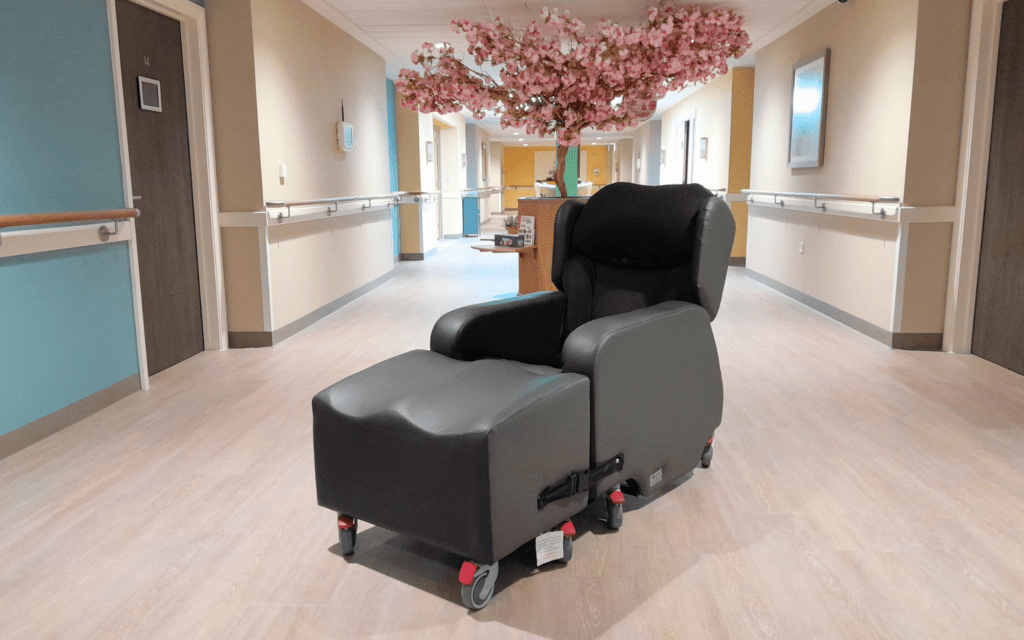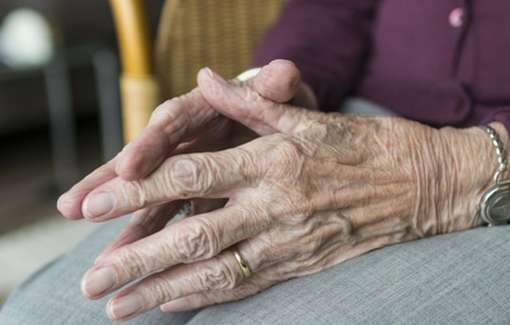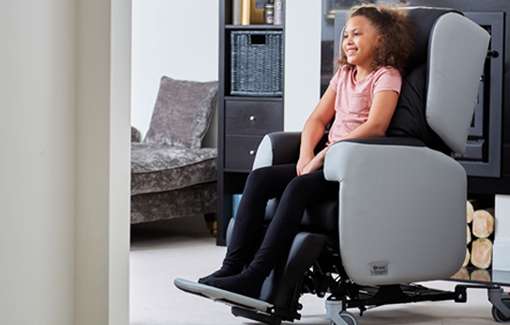When it comes to specialist seating, deciding when to start using a specialist chair is just as important as choosing the right type of chair.
Our equipment advisors book specialist seating assessments for clients every day. Over the years, we’ve helped thousands of families and therapists to find the right seating solutions!
Taking time to fully understand and review someone’s care requirements first is crucial. You don’t want to choose a chair that benefits one area but potentially harms another.
Giving someone too much support too soon can encourage them to rely on their chair rather than their own abilities. That’s not what you want for an older or disabled person looking to maintain their independence!
So, when is specialist seating needed? In this guide, we will look at the hierarchy of provision and the questions you can ask to determine:
a) Whether an individual needs specialist seating.
b) How much specialisation is right for them.
Jump straight to…
What is the hierarchy of provision?
Many healthcare professionals will be familiar with using hierarchies to determine treatment plans.
When faced with a problem that has multiple potential solutions, a hierarchy helps you decide which solution to consider first. Essentially, it simplifies complex decision making!
Here’s an everyday example…
You’ve got a problem – your computer is running very slowly.
The user manual lists several ways to try and fix it:
- Turn it off and on again.
- Update your software.
- Call their customer service phoneline.
This is a hierarchy. You should try option 1 first because it’s the simplest. But if that doesn’t work, there are more advanced solutions you can try to resolve more complex problems.
So, going back to health and social care, the hierarchy of provision is a model for deciding what care equipment to specify for someone.
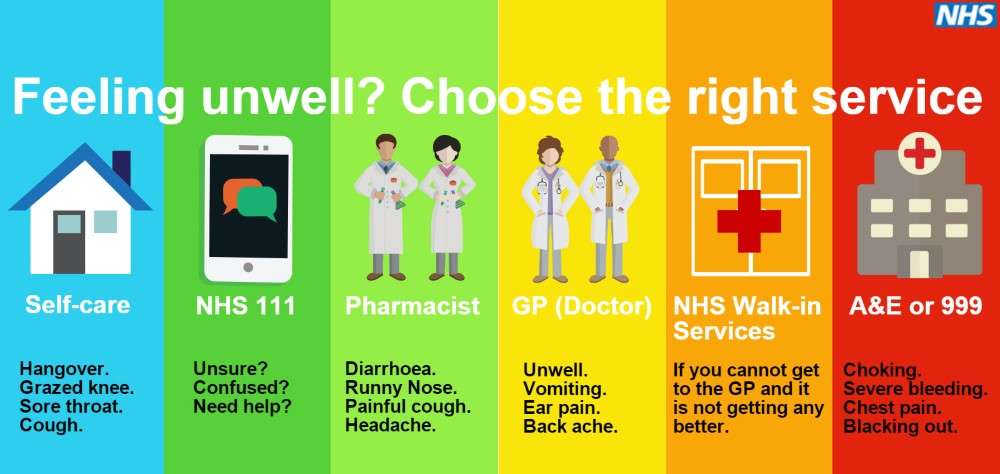
The NHS famously use their hierarchy to help people determine which service they should use first when feeling unwell
Hierarchy of Provision for Specialist Seating
The hierarchy of provision for specialist seating typically looks like this:
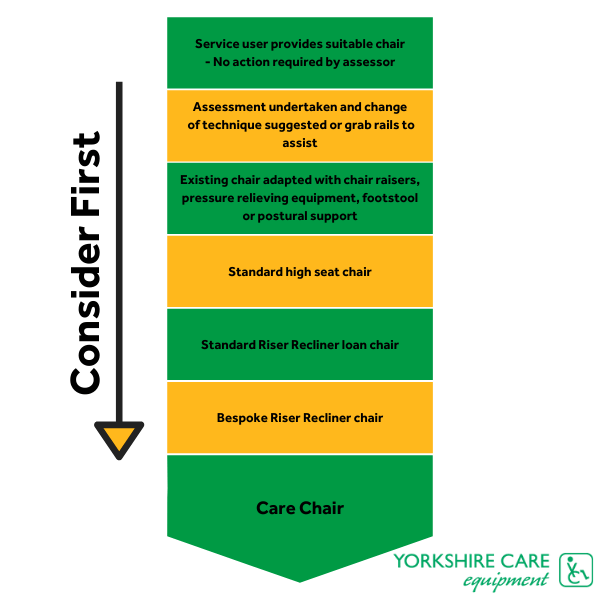
As you work your way down, the seating solutions get more advanced and can support more complex user needs. Just like in our computer example!
How do you know what stage of the hierarchy to start at?
You won’t always need to work through the full hierarchy. Sometimes it’s necessary to go straight to a rise recliner, or even a care chair.
Let’s go back to our NHS healthcare service example. There are times you know to skip 111 and the GP to go straight to A&E! The same applies to provisioning specialist seating.
But how do you know when it’s time to progress to more specialised seating?
That is where seating assessments come in!
To work out what level of support someone needs, you need to assess their posture, medical conditions, abilities, goals, and challenges.
If someone comes to us through an OT referral, it’s extremely likely they’ll require specialist seating. Our assessment team will work with them to find the best-suited chair.
However, if you haven’t had a referral and need some advice for yourself or a family member, we might suggest some other options before trying specialist seating.
Here are some examples of questions we ask to decide what level of specialist seating is best for a client:
Tip: It’s often easier to flip the pyramid and rule out more advanced options first. So, we start with a question that indicates whether someone needs a care chair…
1) Are they hoisted?
Yes: You’re almost definitely looking for a care chair.
Around 95% of our care chairs are specified for people who are hoisted. We’ve written a whole guide on why care chairs are the best chairs for hoisted individuals.
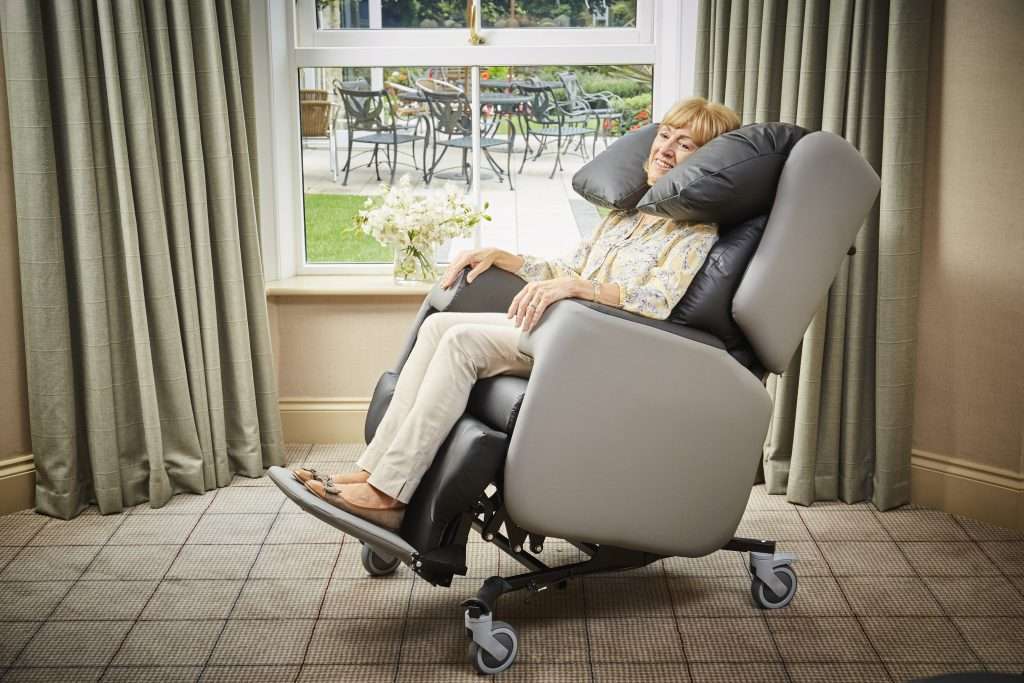
The Lento Care Chair is designed to be used with hoist systems and provide superior support for people who require hoisted transfers
They are the most advanced form of specialist seating and offer unrivalled postural support and pressure care.
No: Move on to Question 2.
We don’t usually recommend care chairs for people who aren’t hoisted.
If someone is still mobile enough to reposition themselves and perform assisted transfers, you want a chair that encourages these actions. Care chairs are designed for use with hoists.
Of course, there will always be exceptions. If you have a client or relative with complex postural needs and think they’d benefit from a care chair, give us a call.
We’ll be happy to give our expert opinion or book in a free assessment.
2) Can they sit down and stand up unaided?
No: You’re probably looking for a rise recliner.
Rise recliners are ideal or people who are still able to sit and stand, but struggle with having the strength or range of movement to do it independently.
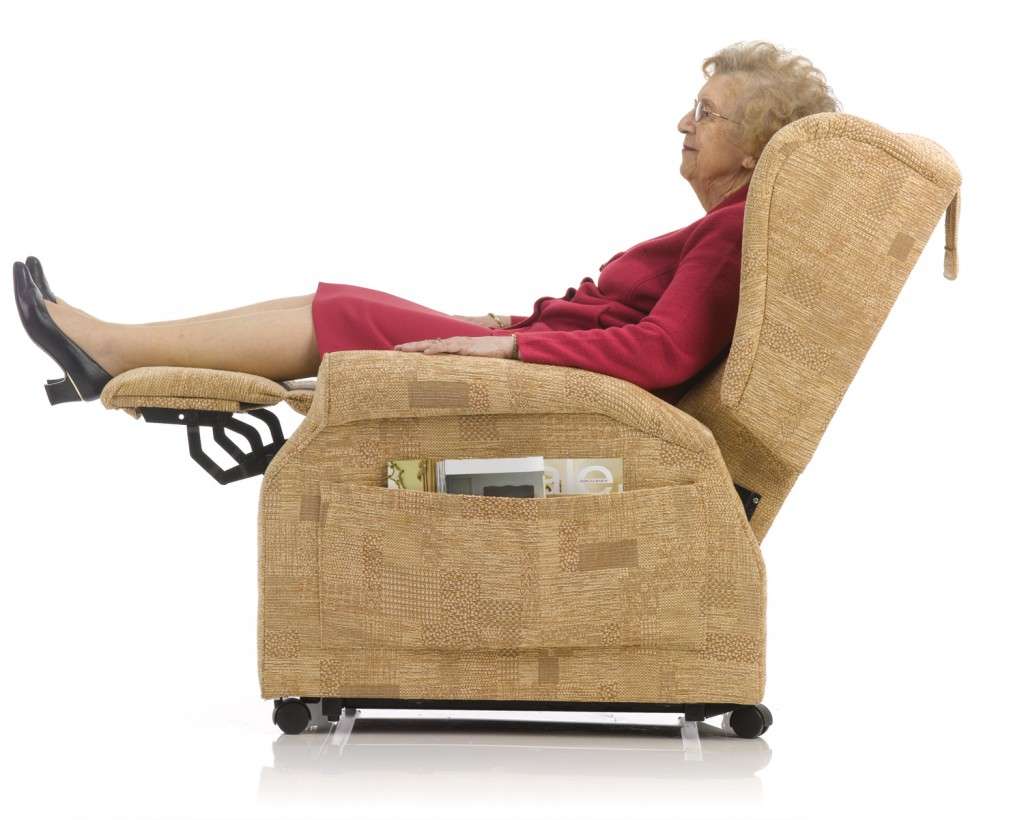
Riser Recliners are a popular specialist seating option for elderly care
Using a handset, the chair can be gently lowered/raised with the user as they sit/stand. This supports their weight as they make the transfer.
Rise and recline chairs allow people to remain more independent and keep their lower body strength whilst protecting against falls and other injuries.
Go to Question 3 to determine what kind of rise recliner would be best!
Yes: Move on to Question 4.
Someone who is still able to sit and stand without any problems won’t get the full benefits of a rise recliner.
In fact, it could even have negative effects on their general mobility. If they start to rely on the chair’s riser action to sit and stand, they can quickly lose strength in their legs and lower body.
This would make walking, using the bathroom, and other everyday activities more difficult.
We want to keep people as mobile and independent as possible for as long as possible! So, encourage them to sit and stand unaided for as long as it is safe to do so.
3) Do they need a long-term solution?
If you’re confident you need a riser recliner, answering this question will help you decide which type is best.
Yes: Consider a bespoke rise and recline chair.
A bespoke riser recliner is made-to-measure. This ensures the seat height, depth, and other dimensions are a perfect fit for the individual user!

Unlike off-the-shelf options, a Bespoke Riser Recliner is made-to-measure for the individual user
Seat sizing has a huge impact on both posture and pressure care. So, when you’re choosing a long-term seating solution it’s important to get it just right.
You can learn more in our Guide to Riser Recliner Sizing.
No: Hiring a standard riser recliner may be a suitable solution.
If you’re after a chair for post-surgery or short-term rehabilitation, then a custom riser recliner may not be necessary.
Standard rise and recline chairs do come in different sizes — usually S, M, L, XL etc. So, they still provide good levels of support. However, they aren’t tailored to the individual user’s needs. That’s why we don’t usually recommend them for long-term use.
4) Is maintaining good posture the only real concern?
Yes: Consider a high back chair.
A high back chair has a high seat back which extends up beyond the shoulders to provide support from the lower back all the way up to the head and neck.
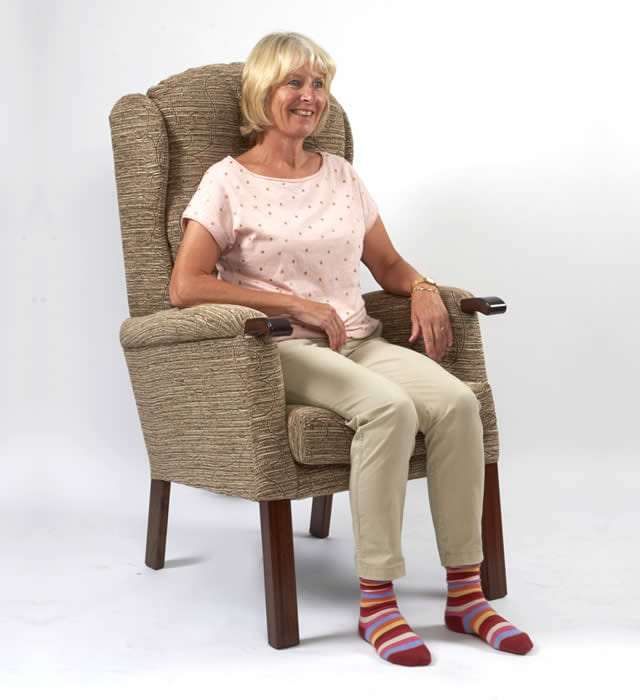
High back chairs may look simple, but they can be great for catching postural problems early and preventing more severe symptoms developing
The design provides greater back and shoulder support than low back chairs. Taking weight off the shoulders and back encourages the user to maintain the neutral back position needed for proper posture.
We often recommend high back chairs for older clients who don’t sit fully upright but are otherwise still very mobile and not at high risk of pressure injuries.
Unlike riser recliners, high back chairs don’t have any electric actions. This is ideal for people who are still mobile because it helps to maintain independence and strength.
Sitting fully upright makes it easier for them to get in and out of their chair. If they can get up and sit down unaided, they have more opportunities to keep active and socialise. Both of which are linked to improved health and quality of life in old age.
No: Specialist seating may not be required yet
If you’ve crossed off care chairs, riser recliners and high back chairs, you might need something other than specialist seating! Take a look at question 5 to find out.
5) Have they got pain in a specific area? Or struggle with one specific action?
Sometimes, we meet clients who are still mobile, active, and generally well supported by their current chair. They don’t have any significant postural problems. But they do experience some pain whilst sitting or struggle with a specific activity.
In these cases, we don’t usually recommend any specialist seating.
Instead, we’d work with the client to adapt their current chair to suit their needs. Here are some examples of equipment we can use:
- Chair raisers
- Pressure relieving cushion
- Footstool
Occasionally, no changes need to be made to the chair at all! With these more specific issues, working with an occupational therapist or physiotherapist can be effective on its own. They can recommend exercises and new techniques to alleviate pains and reach goals.
Reviewing the decision
Once you’ve chosen a seating solution, that’s not the end of the hierarchy of provision! Specialist seating requirements should be reviewed every 6 to 12 months.
Here are some of the things you should monitor:
- Reassess postural and functional objectives
- Document changes in:
- Height and Weight
- Posture
- Medical conditions
- Ability and function
- Lifestyle
As we age, our abilities change and decline over time. A 77-year old woman who was fine in her high back chair last year may require a riser recliner chair this year.
For people with progressive conditions, these changes can occur even faster.
Keeping a close eye on how someone is coping with their chair is crucial. You want to catch any changes early so you can move down the hierarchy of provision and ensure they have the equipment they need!
Book a Seating Assessment to be sure
We hope this has helped you to learn more about the hierarchy of provision and when/how to use specialist seating!
However, the best way to find a seating solution that is tailored to an individual’s needs and lifestyle, and supports their goals, is to book a professional assessment.
Our team have been delivering specialist seating assessments for over 45 years. They’ll provide a free consultation to help you find the right option. If it turns out specialist seating isn’t required, we’ll advise you on the best next steps.
Book an appointment
Error: Contact form not found.







